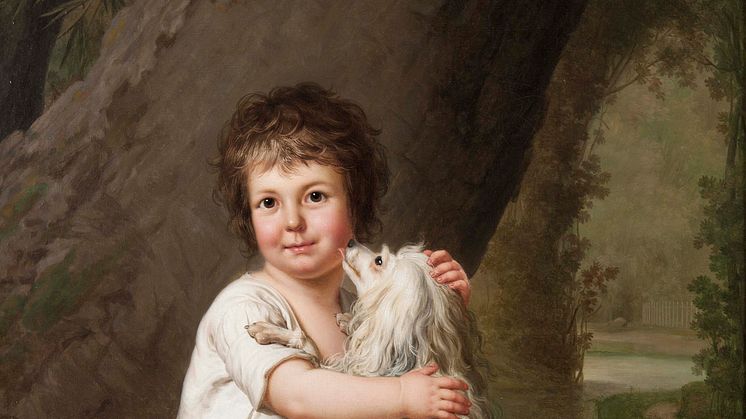
Press release -
New acquisition: Portrait by Adolf Ulrik Wertmüller
Nationalmuseum’s collection of Swedish-French paintings from the 18th century now includes a portrait painted by Adolf Ulrik Wertmüller. It depicts Henri Bertholet-Campan, the son of the French Queen’sFirst Lady of the Bedchamber Henriette Genet-Campan. The acquisition adds an important piece to the fascinating puzzle of Wertmüller’s portrait of Marie Antoinette.
Painted in autumn 1786, the portrait depicts the two-year-old Henri Bertholet-Campan with his dog Aline in the English landscape garden at the family’s summer house in Croissy outside Paris. The painting was exhibited at the Salon of 1787, but under the rather anonymous title of A child playing with a dog.
Adolf Ulrik Wertmüller (1751–1811) trained under his second cousin Alexander Roslin in Paris and studied at the French Academy in Rome. When Wertmüller returned to the French capital in spring 1781, he found it difficult to obtain work as a portraitist and instead earned his keep as a copyist at Roslin’s studio. Here he was discovered by the Swedish Ambassador Gustaf Filip Creutz, who made several important commissions. This in turn resulted in Gustav III convincing France’s Queen Marie Antoinette, during his stay in Paris in the summer of 1784, to let Wertmüller paint her portrait as a gift to the Swedish King. The portrait is currently held in the collections of Nationalmuseum.
King Gustav III had intended this to be Wertmüller’s ticket to a successful career in Paris, but jealousies abounded. When the portrait of Marie Antoinette was exhibited in August 1785, it was attacked by the critics. The Queen was also unimpressed. The artist fell into a deep depression, but recovered enough to make the necessary changes before the portrait was dispatched to Sweden the following year. It was Wertmüller’s friend Henriette Genet-Campan who came to his aid. The fact that Wertmüller even got paid was largely down to Mme Campan, since she managed the Queen’s purse and was intimately involved in the royal finances. For security reasons a mutual friend, Gabriel Lindblom, acted as a go-between in contact between the two. Lindblom had been governor to Mme Campan’s younger brother Edmond Genet and served as an interpreter at the French Ministry of Foreign Affairs in Versailles. This explains why Wertmüller was so well informed and why he came to paint almost a dozen portraits of various members of the Genet-Campan family.
As a show of gratitude to his friend Mme Campan, Wertmüller painted a portrait of her son Henri in autumn 1786. He had already immortalised the child as a new-born baby and would continue to paint other relatives of Mme Campan. These include the portrait of her sister Adélaïde Auguié dressed as a milkmaid in the royal dairy at Petit Trianon-Le Hameau, painted in 1787. This painting has been part of the museum’s collection since 1951 as a gift from the Friends of Nationalmuseum. A study for the portrait of the French Crown Prince Louis has also since been purchased. Now this latest acquisition adds another piece to the fascinating puzzle of how Wertmüller came to paint his portrait of Queen Marie Antoinette.
Further information
Hanna Tottmar, press officer, hanna.tottmar@nationalmuseum.se, +46 8 5195 4390
Press images
www.nationalmuseum.se/pressroom
Categories
Nationalmuseum is Sweden’s premier museum of art and design. The collections comprise older paintings, sculpture, drawings and graphic art, and applied art and design up to the present day. The museum building is currently under renovation and scheduled to open again in 2017. In the meantime, the museum will continue its activities through collaborations, touring exhibitions and a temporary venue at the Royal Swedish Academy of Fine Arts, Fredsgatan 12, Stockholm. Nationalmuseum collaborates with Svenska Dagbladet, Fältman & Malmén and Grand Hôtel Stockholm. For more information visit www.nationalmuseum.se.

